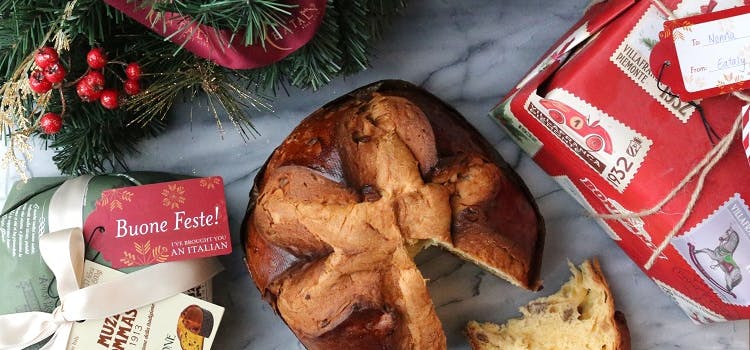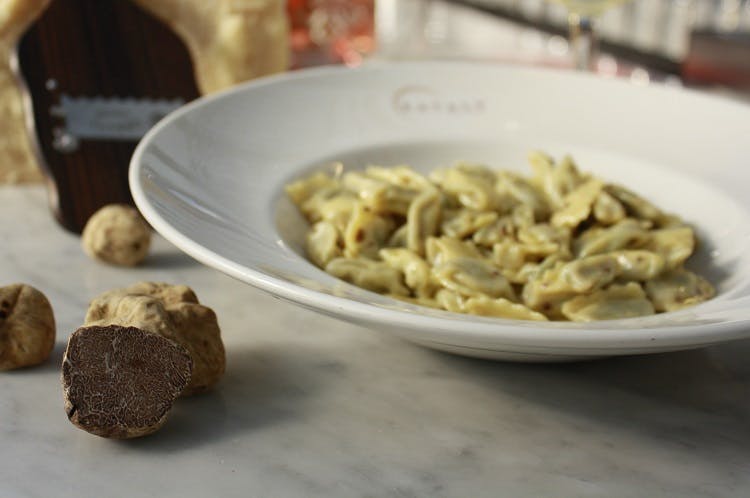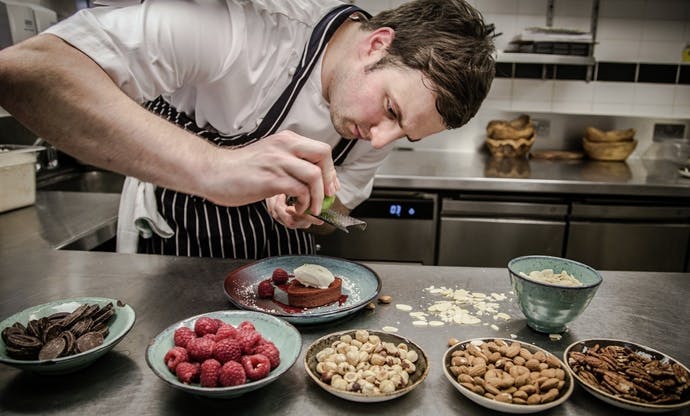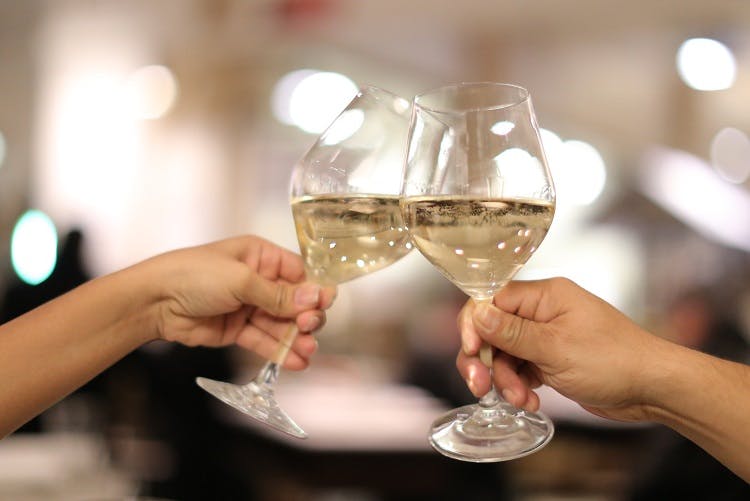In this piece, Great Italian Chefs features editor Tom Shingler compares what Italians love to eat — and drink — during the holidays in northern Piemonte and southern Puglia.
Ask most people what Italians eat for Christmas, and they’ll almost always say panettone; it’s one of the few specialties that have started to influence Christmas celebrations in other cultures. Unsurprisingly for a country with such rich culinary traditions, there are dozens of delicacies that are all but unheard of abroad. So I headed to Italian restaurant Union Street Café in London to talk to the chefs there and find out about some more of the traditional Italian Christmas recipes they cook when they go home.
Head chef Davide Degiovanni hails from Piemonte, a northern, mountainous region known for hearty, meaty, warming dishes which fend off the cold, winter months, while his sous chef, Stefano Decostanzo, was born and raised in Puglia – a southern coastal area known for its brilliant seafood and olive oil.

Piemonte (Nothern Italy)
Bagna Cauda
People from the mountains seem to love fondue. The filling, warming nature of it is perfect when it’s cold outside, and it’s easy to keep it bubbling away throughout the night to be enjoyed by anyone. They’re usually made of cheese, but at Christmastime in Piemonte, they enjoy a much more savory dip made of quintessential Italian ingredients, called bagna cauda. "It’s a mix of garlic, anchovy, olive oil, milk, and sometimes a little cream," says Davide. "You put them all in a pot and simmer the mixture very, very slowly, whisking until it all comes together. It’s very heavy and full of flavor, so you serve it with tall winter vegetables, either raw or steamed, like Jerusalem artichoke, potato, cabbage, carrot, cauliflower, and peppers, which you then dip in the mixture."
Davide says anyone after a gutsy hit of umami will be in culinary heaven, and it’s the perfect dish for feeding a crowd. "My father has seven brothers and two sisters, each with a few children, so when everyone gets together at Christmas it is a big celebration," he explains. "Everyone has been waiting all year long for the bagna cauda, and when the time comes every two people get a little terracotta pot full of the dip between them with a little candle underneath so it continues to bubble away. We start the meal off with antipasti, then move onto the winter vegetables and enjoy."
Cardoons
Even some of the vegetables enjoyed throughout Piemonte are all but unheard of outside Italy. Cardoons look like giant stalks of dark green celery but taste completely different.
"Cardoons are one of the main Italian Christmas recipes we eat during this time of year, but they can be a bit of an acquired taste for someone who’s not tried them before," says Davide. "They’re very bitter and strong in texture and flavor. To properly break down all the stringy fibers, you have to cook them for two or three hours. We usually overcook it, then use the flesh to flavor a flan or soufflé or simply serve them boiled."
Agnolotti del Plin
We’ve all heard of ravioli and tortellini, but there are countless other filled pastas that aren’t ever really seen outside Italy. One of these is agnolotti del plin, a specialty in Piemonte that’s always served at big gatherings, particularly Christmas.
"A lot of the traditional foods we cook at home are rough and ready, so they don’t necessarily work very well in a restaurant setting," explains Davide. "An example of this is agnolotti del plin – which means ‘pinched’ – which we eat at Christmas time. We take a big sheet of pasta and put the stuffing inside, which at Christmas is usually Fontina cheese, but you can use any leftovers mixed with egg, Parmigiano Reggiano DOP, and spinach. You pinch the pasta over each tiny block of cheese, then cut them apart. They’re dipped in hot water for less than a minute, then served in a pile on the middle of the table on top of a napkin covered in Parmigiano Reggiano DOP and truffle. Everyone digs in with their hands; there’s no cutlery. It is absolutely delicious but wouldn’t work in a restaurant like ours!"

Puglia (Southern Italy)
Pettole
Puglian cuisine is known for being brilliant in its simplicity. This is especially true at Christmas, when a few ingredients from the local area are prepared in ingenious ways to create snacks and dishes. Pettole sounds like a pizza-lover’s dream.
"My grandmother used to make pettole for the whole family," says Stefano. "It’s basically pizza dough made very roughly in a pot by hand; nothing more than flour, a touch of yeast, water, and salt. Once you’ve left it to prove for a couple of hours, you grab handfuls of the dough with very oily hands and drop them into a pot of oil to deep fry; the shape doesn’t matter. It’s just so nice and fresh as it puffs up in the oil – you can’t imagine how good it is! I remember waiting for it to be cooked and my grandmother slapping my hand because I wanted to eat it right out of the oil. We used to prepare pettole, then take them over to a relative’s house covered with a basic tomato sauce and some Pecorino grated on top."
Semola Battuta
Puglia’s bountiful coastline means fresh fish usually makes up the majority of the Christmas dinner, but it’s one of the other ingredients the region is famous for – durum wheat – that takes the spotlight in the festive fish soup known as semola battuta.
"Durum wheat makes a much rougher pasta than what you find in the north; theirs is better suited to ravioli and filled pasta as it’s more flexible," says Stefano. "We mix the flour with eggs, Pecorino, and parsley to make a dough, then leave it to rest while we make a fish broth. We then grate the dough into the broth, which cooks it and turns the dish into a sort of soupy pasta. We finish it off with grated sturgeon roe, similar to bottarga."
Cartellate
One of the best things about Christmas is the amount of sweet pastries, biscuits and desserts on offer. In Puglia, sweet wine is one of the flavors most associated with Christmas and is used as the basis for two of the region’s most beloved festive treats, cartellate and vinocotto.
"This is a perfectly balanced dessert and it’s so simple," says Stefano. "We take a sweet dough made with white wine, roll it very, very thin, and cut it into strips. These are then pinched and coiled around in a roll until it almost looks like a rose, and deep fried. Once the cartellate are cooked, we drizzle something called vinocotto onto them. This is a thick syrup made from ten liters of grape juice, which is then reduced down to just one, so you end up with a kind of golden nectar from the gods! It goes really dark and syrupy with a strong grape and licorice flavor. It goes so well with the deep fried dough."

Drinks everywhere
Davide and Stefano describe what they drink throughout the festive season, along with Davide Gagliazzo, the bar manager at Union St Café.
"On Christmas morning, we traditionally always start with an aperitif at the bar in my town while all the wives, mothers and grandmothers cook the big meal – normally a Negroni or glass of Prosecco. Once we get home, everyone has another drink, before moving on to lots and lots of wine when we sit down to dinner. Afterwards, we always have a grappa. By four or five o’clock in the afternoon, most people are asleep!" – Davide Gagliazzo
"Back when I lived in Puglia, I always used to make infused spirits with my grandparents. We’d take things like bay or walnut leaves in October and steep them in alcohol. In December we’d finish them off with a little sugar syrup and they’d turn out like limoncello but all sorts of different flavors. There was always a lot of spiced wine going around, too, flavored with fruit, spices and citrus peel." – Stefano Decostanzo
"The grolla is something nobody really knows about outside Italy. You can use it throughout the year but we’d normally put it on the table at Christmas because it’s meant to be used at family gatherings. It’s a sort of lidded clay jar with lots of little spouts to drink out of, which we fill with a mixture of coffee and either brandy, cognac or grappa. You pass it around the table and everyone has a sip. Grolla is very common in the mountains of Piemonte when it’s cold outside; everyone sits down next to the fireplace and passes it around." – Davide Degiovanni
